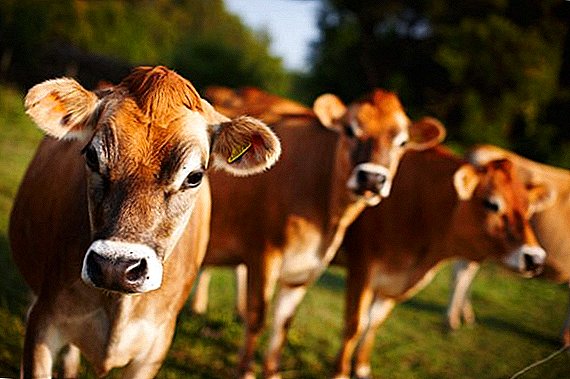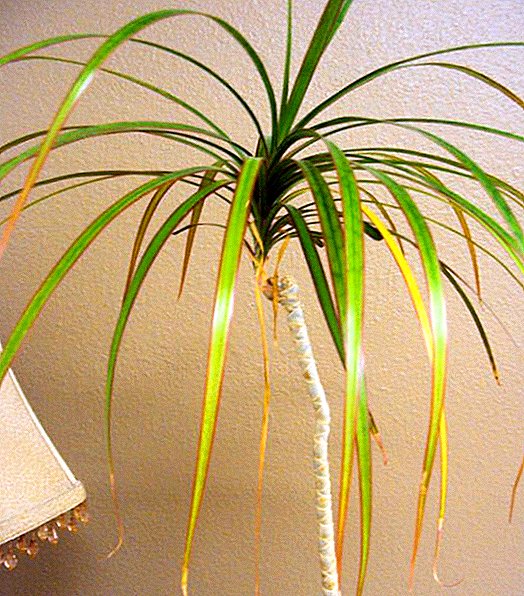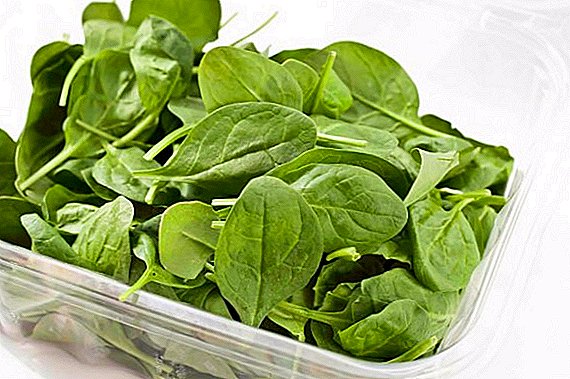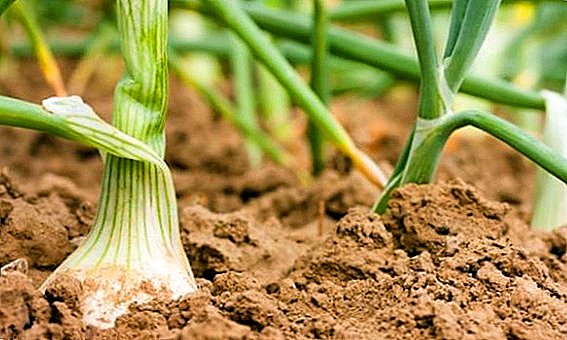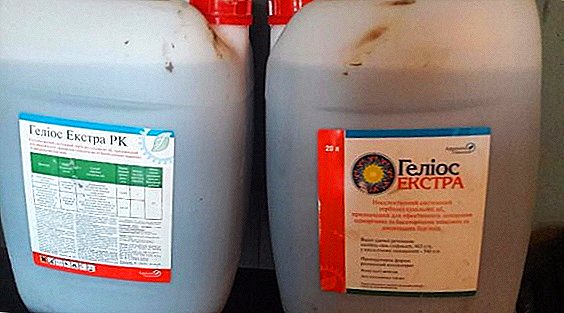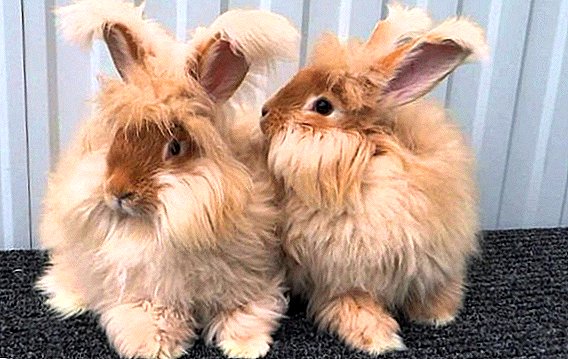 Angorka is the most common breed of rabbit in the world. Products from soft down of these animals were always appreciated.
Angorka is the most common breed of rabbit in the world. Products from soft down of these animals were always appreciated.
Angora rabbits are cute and charming, but it should be noted that for their maintenance and breeding, you need to take into account certain specifics, which we describe in our article.
For what purposes are Angora rabbits bred
The dwarf Angora rabbit, or Angora, is a breed of rabbits that is known as downy fur because of the voluminous fur that distinguishes these rabbits from other breeds. This breed is very popular in Western Europe, they are gray, black, blue and white color.  Many livestock breeders include Angora rabbits as dwarf breeds, as they rarely reach a weight of more than 5 kg. Therefore, rabbits of the Angora breed are used primarily for the production of fluff, as well as for decorative purposes.
Many livestock breeders include Angora rabbits as dwarf breeds, as they rarely reach a weight of more than 5 kg. Therefore, rabbits of the Angora breed are used primarily for the production of fluff, as well as for decorative purposes.
Did you know? Angorka is one of the oldest breeds of domestic rabbits. They learned to breed her in the capital of Turkey - Ankara, which in ancient times was called Angora.At present, the largest producer of Angora rabbit fur is the People’s Republic of China, where production is more than 8 thousand tons annually. In European countries, however, this number does not work, although the Czech Republic, Poland, Hungary and France are also famous for the breeding of this species.
You will also be interested to read about such breeds of rabbits as the white giant, butterfly, gray giant, ram, rizen, flandr, black-brown rabbit.The incredible fur of these animals is very much appreciated, since it consists almost entirely of downy hair. High quality products are obtained from such wool. Angorah fluff is also used to make felt velor as well as knitwear.
 Despite the flow of mass breeding of rabbits for industrial purposes, the Angora decorative rabbits are very popular as pets due to their aesthetic unusualness and attractiveness.
Despite the flow of mass breeding of rabbits for industrial purposes, the Angora decorative rabbits are very popular as pets due to their aesthetic unusualness and attractiveness.Down Rabbit Breeds
The most common breed of Angora rabbits: English, satin (satin), white downy, giant, French.
Did you know? Homeland Angora rabbits Turkey. They got to Europe thanks to sailors who bought several rabbits and brought them to the Europeans.
- English downy breed of rabbits. English rabbits weigh 2-3.5 kg. Possess broad head and flat muzzle. The body of these animals is completely covered with hair, except for the nose and small areas on the paws. English rabbits are combed every three days.
- Satin (satin) breed is slightly larger than English and weighs from 3 to 4.5 kg. The fur is especially soft and absent on the face and paws. When compared with other breeds, they give less wool. But their wool is better, as it is more durable.
- White down breed rabbits. This breed of domestic animals was bred using the method of absorbing the crossing of two breeds: tongs (unproductive down rabbits) and Angora rabbits. The coat of these rabbits is elastic and pure white. Wool consists of 92-96% of down and 4-8% of guide and guard hairs. In the white downy breed, the length of the down reaches 5-7 cm.
- Giant rabbits gain weight from 4.5 to 6 kg. Very fluffy, have tassels on the ears, fade a little. Thoroughbred Angoras have only white color.
- Rabbits of French breed reach a weight of 3.5-4.5 kg. The wool of this breed is unpretentious and does not require scrupulous care.

External data
Angora rabbits differ in body, which is shorter than in other breeds, and is similar to a cylinder. The head is large with short, dense ears. Ears differ hair tassels. The legs of the animal are strong and straight.
Silky thick coat covered the entire body of the animal. In an average individual, the fur reaches 25 cm, with a density of 92%. Coloring can be various, especially individuals of white color are appreciated.
Weight usually ranges from 3 to 5 kg, there are also individuals that reach 6 kg of live weight. The maximum weight of the young members of the breed reach 7 months. The average lifespan of rabbits is 5-7 years, some individuals live to 10 years. 
How to choose the Angora rabbit
European varieties are estimated by the following parameters: constitution and body shape, weight, length and thickness of wool, quality of wool, as well as color and degree of care.
Important! It should be remembered that the abundant wool cover makes it difficult to study the shape of the body, and you can skip some physical defects. For this reason, when choosing, they are recommended to grope the rabbit.When studying wool, you should make sure that it is thick all over the body, dense and grows evenly. You can measure the ideal length of the coat in this way - take the wool in a bun and measure the size of the beam, it should be at least 6 cm. Also, the wool should not fall off.
Light defects can be considered:
- not very thick coat;
- not thick coat;
- slight dysplasia;
- easy stalling wool.
In the color of the breed admit all the same color shades, it must be clean, the relevant requirements of the breed, including the color of the claws and eyes. 
Weak defects in color are:
- unclean color;
- eyes and claws of a different color;
- small amount of white hairs.
Pay attention to strong defects, namely:
- mixed and discolored colors;
- a large number of white hairs;
- discrepancy in color of claws and eyes.
Content and feeding
Angora rabbits are gentle and fearful creatures. Before you pick him up or stroke him, allow him to sniff up his hands. These animals are very playful and love calm voice and affection. Let's take a closer look at what needs to be done in order for a healthy, active rabbit to grow up with beautiful fur.
Tips for the right content
You can keep rabbits in enclosures. Aviary is a small fenced sector, covered from above. In the aviary must be:
- grass / hay compartment;
- feeder or food bowl;
- drinking water with clean water;
- animal house;
- inedible mats;
- toys;
- restroom.
It is recommended to shade a part of the aviary, as well as to install a box or a house, because the rabbit is a burrowed animal and will hide there. When buying dishes in the aviary, you should give preference to ceramics. Such dishes are necessary due to the fact that the rabbit throws up all the objects that he grabs with his teeth, and the ceramic dishes are heavy, and he cannot lift it.
Rabbit easily gets used to one place for the toilet, so you should accustom him to the tray (you can cat). 
Grooming
For animals, it is necessary to ensure almost sterile cleanliness in the aviary. If this is not done, the wool will quickly get dirty and tangled. Such fur will be hard to comb and cut.
Angorans are recommended to cut once a month. You need to do this manually. If necessary, then pluck wool. The special structure of the Angora rabbit fur needs frequent and regular care. In rabbits of the English breed, the down is fastest.
And the slowest of all - in the satin, French and giant breed. Representatives of these breeds have the toughest fur, which is less likely to form mats. You need to brush the animals with a special brush and at least once a week.
Be sure to remember that a healthy rabbit is forbidden to bathe. 
What to feed
Animals of this breed eat a little, but constantly. Food should consist of green and succulent feed, and grain and concentrates minimize to a minimum. The diet should consist of:
- tuber crops - sweet potatoes, potatoes, Jerusalem artichoke;
- root vegetables - carrots, beets, radishes;
- fruit - mostly apples;
- fresh grass or hay.
Also, the harvesting for the winter can be done by yourself - in the summer, mow and dry the grass or gather the twigs.
Learn all about feeding rabbits at home.Angoras should not be given white cabbage. From her puchit belly, and the animal may swell and even die, so you need to carefully monitor what to feed the rabbits.

Vaccinations
It should be remembered that these animals are very sensitive to intestinal and gastric diseases, therefore, regularly check with a veterinarian.
Did you know? The Angora breed came to our country from Germany in 1927. Our specialists developed a separate subspecies of the Angora in the middle of the last century.
Vaccinations Angoras do more than other breeds. At the age of 45 days do the first, after 3 months - the second.
Further vaccinations are repeated twice a year. If the pet has become sluggish and has lost his appetite after the vaccine, do not worry, this is a normal adverse reaction to the medicine. 
Breeding (breeding) rabbits
Angorka differs from other breeds also in late puberty. Females can happen after 12 months, while other breeds happen at 5-6 months.
At one time, usually 8 rabbits are born in a rabbit. Care and comfort is very important for a pregnant rabbit. In order for the period of pregnancy to go well, watch the level of humidity and temperature, do not allow their sudden drops, it is very dangerous for the animal.
Then you will get fertile, healthy and strong offspring. When breeding down rabbits adhere to this ratio: 70% of the rabbits are kept as downy-noses (for down), and 30% are needed for breeding (to replace old and sick animals in the herd).
After the rabbit gives two generations, it continues to be used only as a puffin. 
Harvesting and processing of rabbit fluff at home
In terms of quality, finished rabbit down products are on a par with cashmere and alpaca. Unlike this wool, rabbit fluff does not need additional treatment (spine removal, washing and drying). Due to this, costs are reduced, and you can make products from rabbit down on your own at home.
Stocking
Rabbitheads use two basic ways of harvesting fluff: plucking and shearing. It should be noted that when shearing, the quality of down is reduced, since down is obtained in different lengths and structures. After shearing, fluff grows more slowly than after plucking. This is because after plucking increases blood circulation, which stimulates hair growth, which reaches 0.7 mm per day. In addition, when plucking, the down is better and more uniform.
To remove the down from the animal, you need to sit him on his knees with his head to himself, comb the wool with a wooden comb. Combing should start from the back, rump, sides and neck.
Fingers of the right hand to press to the comb part of the hair and comb them in the direction of growth. If the hair has matured, it is separated very easily. Then the animal is turned on its back and combed hair on the stomach and sides. From the rump, you need to pull out the fluff very carefully, cut off the tail better, so you do not damage the skin. In winter, the plucking is carried out partially, so as not to expose animals in the cold period.
The first plucking of juveniles is carried out at two months of age, with about 15 g of fluff being obtained. The second time they pull out at four months of age and collect two times more fluff. The third time a pinch is carried out at the age of six months and 35 g of fluff is collected.  After that, pluck should be every month. It should be remembered that the quality and quantity of wool depends on the season. Increase the collection of fluff will allow healthy, quality food and good care. It is also necessary to observe the daily regimen and keep the cells dry and clean.
After that, pluck should be every month. It should be remembered that the quality and quantity of wool depends on the season. Increase the collection of fluff will allow healthy, quality food and good care. It is also necessary to observe the daily regimen and keep the cells dry and clean.
Storage
Rabbit hunters recommend storing the collected rabbit down in wooden boxes with lids tightly closed. Lay down loosely.
Important! In order to secure the collected lint, the bottom of the drawer in which lint is stored is lined with parchment paper, and a bag of naphthalene or other insecticide is attached to the wall.In order for the down to not fall down, make holes in the bottom of the drawer with a diameter of 1 centimeter in a checkerboard pattern, 12 cm apart. Insert pegs 20 cm long into these holes. These stakes should be easily removed so that you can quickly clean the box.
Recycling
Rabbit wool can be used for knitting scarves, hats, sweaters and other clothing. First you need to first prepare the rabbit fluff - clean from debris, hay, grass. Lay down need to straighten.  After cleaning, the fluff is combed using a special hand-made scab - a wooden plank approximately 20 cm long and 5 cm thick. On the upper part of the plank steel needles up to 7 cm high and 1 cm apart are fixed in two rows. The comb will be laid between the knees, put a rabbit Fluff on the needles and stretch in different directions.
After cleaning, the fluff is combed using a special hand-made scab - a wooden plank approximately 20 cm long and 5 cm thick. On the upper part of the plank steel needles up to 7 cm high and 1 cm apart are fixed in two rows. The comb will be laid between the knees, put a rabbit Fluff on the needles and stretch in different directions.
Combed down folded layers. The height of the stack is convenient to do up to 10 cm. After that, the opposite ends are twisted to each other by a roll. For fluff yarn use spindle, it is recommended to spin without increased tension. In pure form, rabbit down is not spun. For a basis take a woolen thread or cotton. On these threads down keeps better.
The bobbin thread is not suitable for the base. For the creation of small downy products, 40-80 g are used, for shawls - 200 g, and for sweaters or sweaters - 300 g of yarn.


